
The number one thing you need to do to protect a building is control water. As the Canadian building scientist Gus Handegord said, “The three biggest problems in buildings are water, water, and water.” So, with the 1961 house I bought this year, one of the first things I discovered was the failure at the edge of the roof. The gutters weren’t working well, resulting in water getting into places it shouldn’t be and rotting out the soffit and fascia boards in multiple places around the house.
Last week, we had a contractor out to begin fixing the water problem by replacing the soffits, fascias, and gutters. The first step, of course, was removing the old stuff. And that’s when an air-sealing and insulating opportunity arose for me. Let’s take a look.
What is behind those boards?
When the soffit space was opened up, I learned a few things. First, the sheathing behind the brick veneer on our 1961 house is gypsum board. I was expecting asphalt-impregnated fiberboard, like I found behind the brick veneer on the 1970 condo I owned before moving here. That gypsum raises a host of questions that I won’t explore here, but the second thing I learned is that the electricians took the easy way out because of this material choice.
In the photo below, there are two wires coming from the attic, going across the top plate, and then into the wall through a hole punched in the gypsum. Hey, it’s a lot easier to knock a hole through gypsum than drill through three inches of wood top plates, right? In addition to the wire holes, the gypsum sheathing, which is where the continuous air barrier should be, was broken in other places, too. See that big hole between the two wires?
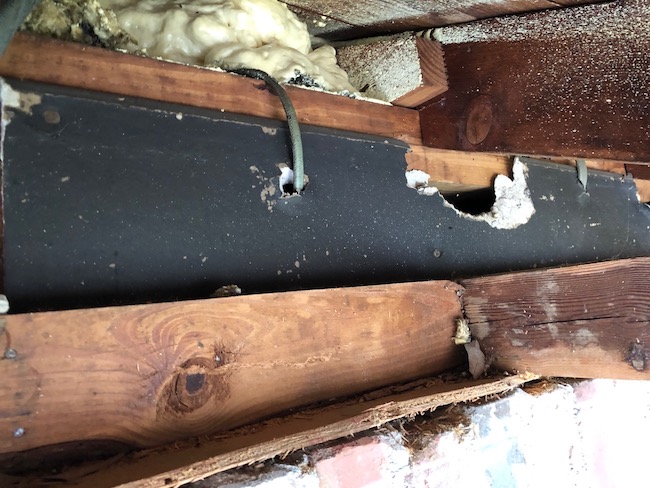
The third thing I learned is that when spray foam installers are encapsulating an attic, they can miss insulating and air-sealing over the top plate of the exterior wall. I wrote about this problem in my article last week. The photo below shows what happens.
The spray foam installer can’t get a good angle to make the foam stick in that open gap and they usually don’t put blocking in there. So the foam overshoots the gap, which is clearly evident below. Note the spray foam shadow where the end of the ceiling joist is. (See that article, Spray Foam Insulation at the Edge, for more details.)
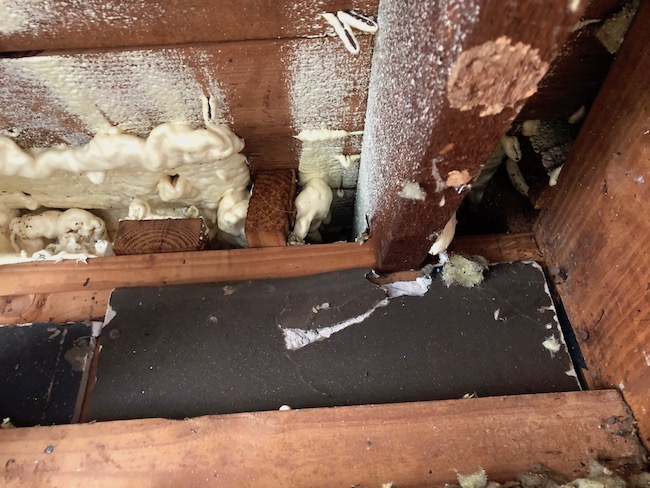
Also to be noted in the photo above is the seam between the pieces of gypsum sheathing. There’s no tape or other kind of sealant to cover that gap, so there’s another place that air can go into or out of the walls.
How to fix it
Since this attic is encapsulated with spray foam, the solution is easy. I got myself a couple of two-part foam kits (photo below).
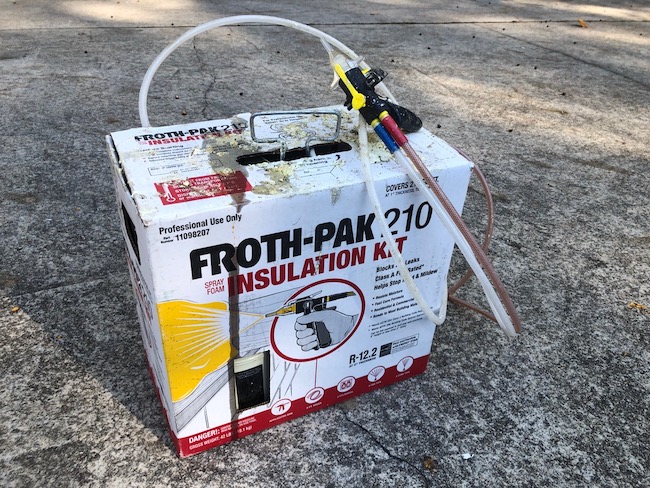
The next photo shows one of the rafter bays after spraying. I did three things there:
- Filled the end of the cavity with foam. That provided insulation over the top plate of the exterior wall and sealed any penetrations in the top plate as well as the gap between the top plate and ceiling drywall.
- Sealed the top edge of the gypsum sheathing.
- Sealed the seam between two sheets of exterior sheathing.
There were no cable penetrations in this bay, but I sealed those up wherever I saw them, too.
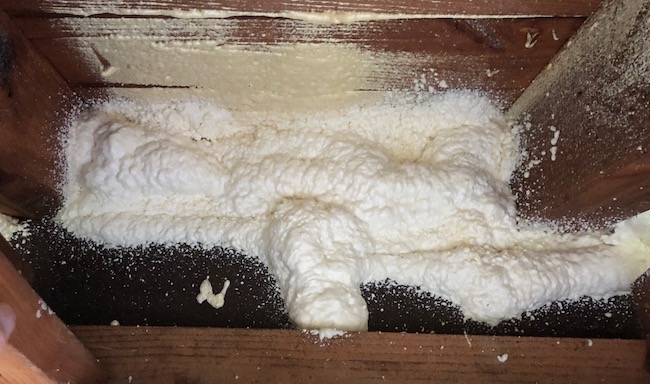
If I were dealing with a vented attic instead, things would have been more difficult. I still would have sealed all the seams, edges, and penetrations in the gypsum sheathing, but I wouldn’t have filled the rafter bays with spray foam. That would eliminate venting from the soffits. To keep the attic vented and get the top plate sealed and insulated from outside would be important but tricky. I’m interested to hear what others have done in that situation.
Understanding the air barrier
When the contractor’s workers got the first part of the soffit opened up, I missed some of the sealing. I had a foam gun and three cans of foam as well as a two-part foam kit, but that first kit didn’t work. I did the best I could with the gun, but it wasn’t up to the task. It killed me to do it, but I had to leave about 20 feet of the rafter bays and sheathing incompletely sealed and insulated.
I was talking to the contractor and lamenting having to watch his workers cover up that one part of the house without sealing it up first. He said, “That doesn’t matter. It’ll be sealed up once we put the soffits and fascias back up there.”
He’s a smart guy and does really good work. He doesn’t often have to think about where the air barrier is, though. In this case, what he said was incorrect because that space in the soffit is connected to other places. It’s connected to the vented attic over the garage. The fascia isn’t sealed at the top edge, which will be covered—but not sealed— by the drip edge. The soffit and fascia are not the air barrier.
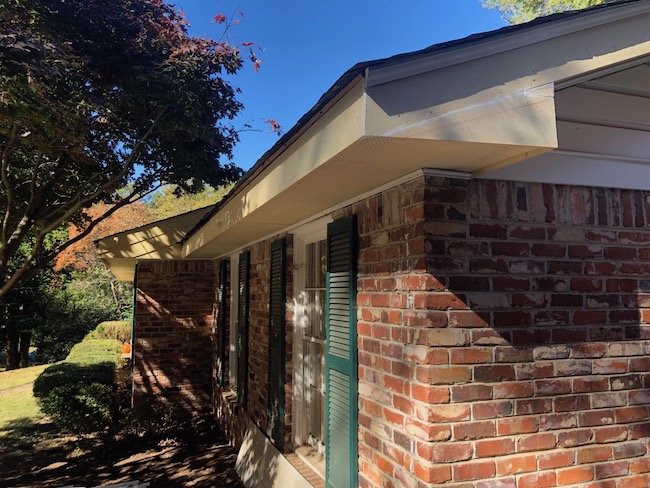
The soffit crew is just about done with installing the new stuff. The photo above shows the front of the garage. Soon we’ll have the painters come do their thing and then have the soffit company come back and install the new gutters. At that point, we will have made a big stride in solving the problems of water, water, and water. And I snuck in and helped with the problems of air and heat, too!
Allison Bailes of Decatur, Georgia, is a speaker, writer, building science consultant, and the author of the Energy Vanguard Blog. You can follow him on Twitter at @EnergyVanguard. Photos courtesy of the author.
Weekly Newsletter
Get building science and energy efficiency advice, plus special offers, in your inbox.





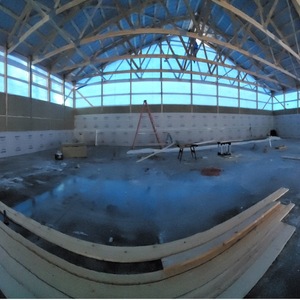
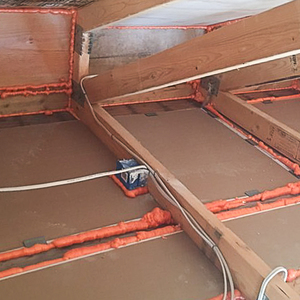
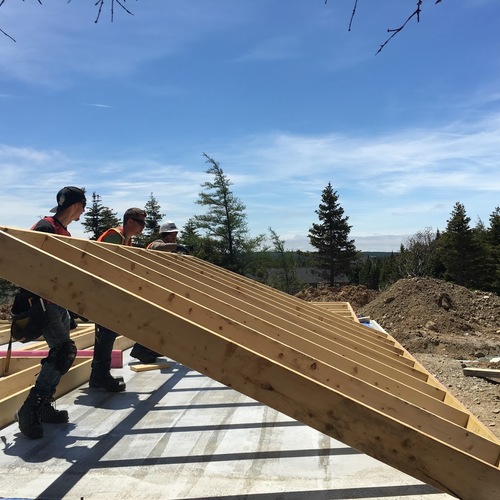
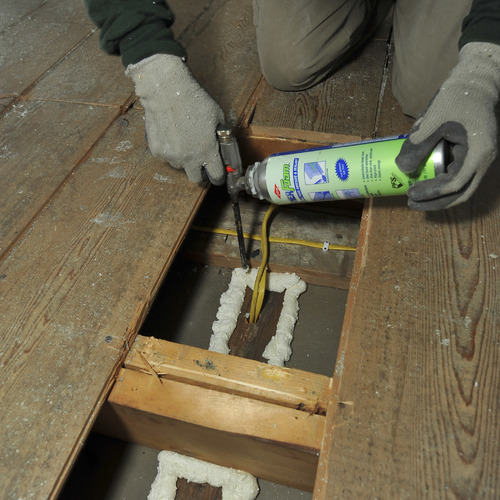






3 Comments
Way to go Allison!
I did write about our 60s house that is alot like yours in GBA with details. You always have to watch over the guys doing insulating work no matter what they are blowing in. When I do deep energy retrofits now, I have the guys do both inside and outside so they see what they missed (and they always do!). They learn and I don't have to worry about calling them back. They really don't mind as long as I leave good reviews and each time they do a better job. All about relationships, eh? The last three homes I did including an 1880 hit .5 ACH. Better than Pasiv. So tight they had to pay extra for the furnace guys to bring in more air for combustion. They didn't mind!
"If I were dealing with a vented attic instead, things would have been more difficult. ....keep the attic vented and get the top plate sealed and insulated ....important but tricky. I’m interested to hear what others have done in that situation."
Great article, Allison. Thanks!
I'm VERY curious to know what, if anything, you've heard back from "others" about solving the top plate challenge in a vented attic scenario....because, of course, that's exactly my (and lots of other Canadians') situation on my 35 yr old, multi-level home.
I was just quoted close to $10K to remove the original batts and subsequent, blown-in cellulose and replace with spray-foam. But, as someone commented, I'm nervous about them being vigilant in the outer reaches of the low-pitched roof on the "one-story side" of my multi-level split.
Hi Allison:
Great article about detailing an important location - it helps illustrate the challenge of retrofitting to an unvented attic, especially on a low sloped roof often found on brick ranches in our area.
We had a similar project on a much larger scale at Peachcrest Boys and Girls Club. They needed to re-roof an enormous vented shingled roof with ductwork located above the dropped ceiling (there really was no ceiling air barrier!). Rather than spray foam from underneath, we had them install rigid poly-iso board above the roof deck which was then covered with metal roofing.
I was a bit surprised at how much time and attention we spent detailing the roof to wall junction (after BD testing 50+ commercial buildings, that's a common failure point) - but we knew it was critical. We wrote a spec that required them to (when possible) access it both from the inside as well as the outside at the soffit.
A big job but very successful - they are thrilled with the humidity, energy and performance improvements. I shudder when I think about how many existing buildings need this kind of fix!
I'll try to attach a Google Maps image. Best, -mikeb
Log in or create an account to post a comment.
Sign up Log in